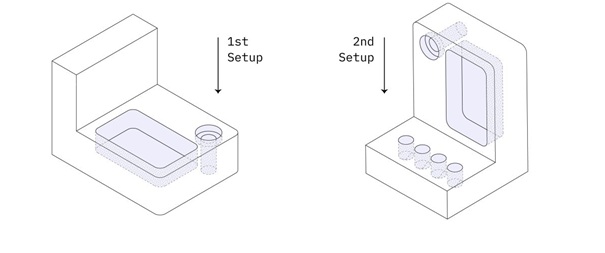Nowadays there are many different ways to develop a three dimensional project. Obviously, you can use a 3D printing service for this purpose. On the other hand, you may decide to use a different method. An example of this is CNC machining, which is a subtractive manufacturing technique. This essentially means that it will cut off parts of a solid block, which is often called a blank or a workpiece. This block is some type of material and will be made smaller with the help of multiple cutting tools. If you are going to use CNC prototyping, you obviously do not want to spend too much. How you can do this will be explained below.
Amount of machine orientations
Table of Contents
If you are going to use a 3-axis CNC mill and design a part that requires two machine setups or even more, the manual labor will be increased. This is the case since the workpiece has to be rotated manually after the features on one side of the product have been machined. Since there will be more manual labor, the costs will increase as well. However, you can also utilize a multi-axis CNC machine. This will increase the machining costs unfortunately by circa 60 to 100 percent. Minimizing the costs can be done by designing pieces that can be machined in one setup in a 3-axis CNC mill.
Material costs of CNC machining
Many different materials can be used in CNC machines. Obviously they all have different costs. If you want to minimize the amount of money you spend on this technique, you should select the cheapest material. However, this material still needs to have the properties to fulfill your design requirements. In other words, you need to pick the cheapest material that still achieves the goal of your designed product.
Increasing or adding

By reducing the machining times, you will reduce the costs as well. This can be achieved by adding a fillet that is as big as possible to the internet and external vertical edges. This way the machine can employ a larger tool, so more material will be removed with each cut, while the speed can be higher as well. If you need a 90 degree internal edge, the radius cannot be reduced. In this case, it is better to use an undercut. This way you will still save money.
Minimize the number of machine orientations
The part above requires at least two machine setups in a 3-axis CNC mill. After the features on one side are machined, the workpiece is rotated manually. This requires manual labor increasing costs. Alternatively, multi-axis CNC machines can be used. This also increases the machining costs though by about 60 to 100%.
To minimize cost:
Design parts that can be machined in one or two setups in a 3-axis CNC mill.
If this is not possible, consider splitting the part into multiple geometries that can be machined in one setup and assembled later. Order low-cost, precision CNC machined parts from a network of manufacturers across America, China, Europe & India. You can compare and upload your parts for an instant CNC machining quote online.
Increase the size of all fillets or add undercuts to sharp edges
To reduce machining times, add a fillet that is as large as possible to all internal (and external) vertical edges. This way a larger tool can be used, removing more material with each cut, and a circular toolpath can be followed, cutting each corner at a higher speed. When a 90° internal edge is needed, reducing the radius will not do the job. In these cases, use an undercut instead (see above).
To minimize cost:
- Add a radius that is slightly larger than 1/3 of the depth of the cavity.
- Add a small fillet also to external edges.
- Use undercuts when a 90° internal corner is required.
- Pro tip: Use the same radius for all edges to save time on tool changes.







